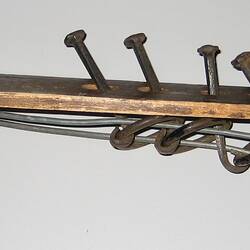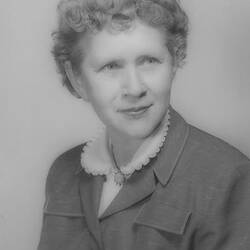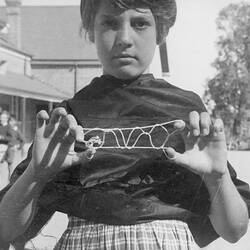Summary
Hand-made puzzle consisting of seven rings and a hoop, attached to a board. It was made about 1890 in the mountains of Maryland, USA, for adults.
The puzzle is described and illustrated in Cassell's Book of In-Door Amusements, Card Games & Fireside Fun, 5th Edition, 1888, p.93. It is called 'The Seven-Ring Puzzle', within a group labelled 'The Puzzling Rings'. 'The puzzle is smart and neat, but the parts have to be so nicely fitted, that it would not be easy for an amateur to make it. It may be purchased at small cost at any toy-shop...The puzzle...is to take off the rings.' Instructions are given for solving the seven-ring puzzle, 'that being the simplest form in which the puzzle is made'.
This puzzle is a version of a wire puzzle called the Chinese Ring Puzzle, illustrated in 1725 in a French publication. Early examples of this puzzle were often made of wire, seven ivory rings and a beautifully carved ivory handle. In the nineteenth century a great many wire puzzles came on the market, and were often included in publications of Victorian parlour games. Complete Chinese wire puzzles are not often found, as they consist of small parts which can easily be lost.
Physical Description
Puzzle, handmade from wood, nails, metal rings and metal strips. The base is an oval shaped piece of wood. Seven holes are drilled to form a row at one end. A thick nail is threaded through each hole and the end of the nail is bent to form a loop, through which a metal ring is secured. A heavy piece of wire passes through the loops, along which the rings can be worked to form the puzzle.
Significance
The object is part of the Dorothy Howard Collection, contained within the Australian Children's Folklore Collection (ACFC). The ACFC is unique in Australia, documenting contemporary children's folklore across Australia and in other countries reaching back to the 1870s. The Collection has a strong component of research material relating to Victoria.
More Information
-
Collection Names
-
Collecting Areas
-
Acquisition Information
Cultural Gifts Donation from Dr June Factor, 18 May 1999
-
Acknowledgement
Donated through the Australian Government's Cultural Gifts Program.
-
Place & Date Made
-
Classification
-
Category
-
Discipline
-
Type of item
-
Overall Dimensions
5 cm (Length), 37.5 cm (Height)
-
Keywords
Handmade Games & Toys, Pastimes, Puzzles, Recreation, Woodworking





